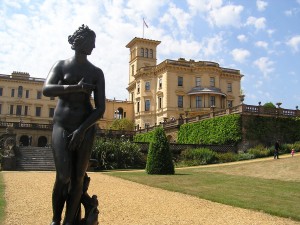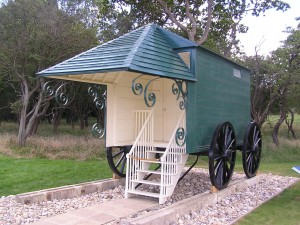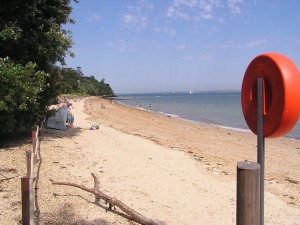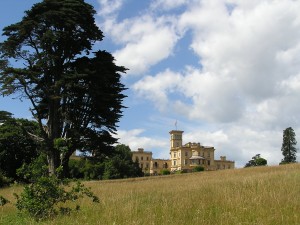I have been to Queen Victoria’s private beach at Osborne, on the Isle of Wight, to swim. English Heritage, who manage the estate, have restored the alcove or exedra, colourfully decorated with blue and pink tiles, which she favoured for letter-writing and sketching. The Queen’s bathing machine, also restored – after lengthy service as a chicken coop – is displayed there, a very superior construction akin to a small house. Deck chairs may be hired, there are regular Punch and Judy shows, brass bands occasionally perform and there is a pleasant café with changing facilities.
It was here that Queen Victoria bathed for the first time, when she was in her late twenties. In her journal for 30 July 1847 she writes: ‘Drove to the beach with my maids and went in the bathing machine, where I undressed and bathed in the sea (for the 1st time in my life)… I thought it delightful till I put my head under water, when I thought I should be stifled.’
In fact, the sea here is so shallow, except at the highest tides, that one could almost walk to Portsmouth. As a swimming place it is ideal for young children, as there is little danger of their getting out of their depth. Queen Victoria’s own children played happily on the beach for hours and had swimming lessons from Prince Albert, a firm believer in the health-giving properties of sea-bathing. Although the Solent is a narrow strait, the view from here reminded him of the Bay of Naples.
I wondered whether my grandfather, a cadet at Osborne during the First World War, would also have swum here. In 1902, Edward VII presented Osborne to the nation. A year later, a Royal Naval College was opened in the former stables, the main house being put to use as a convalescent home. The accommodation was damp and spartan, a suitable training ground for the nation’s martial élite. (These included Prince George, later the Duke of Kent, who was my grandfather’s servant.) The College was to become notorious for its epidemics of ‘pink eye’, a minor but unpleasant infection, treatable with drops, that was said to have been left behind by the horses.
Disappointingly, I discover that there were no opportunities to swim, nor indeed swimming lessons, in my grandfather’s day. There was no pool, and the Admiralty had banned swimming in the Solent, on the improbable grounds that it was unsafe! Swimming lessons were deferred until the boys arrived at Dartmouth, which had a pool, though I suspect my grandfather would already have been a competent swimmer.
One of the delights of visiting this beach is the path from the main house that leads to it. A near contemporary of my grandfather writes: ‘the grounds which formed the park of Queen Victoria’s favourite country home … were quite lovely. Though we were not allowed to approach the house, on half holidays and Sunday afternoons the paths through the woods and down to the sea were open to us, and in the infrequent intervals between organised games I used to love to wander there. But our lives were so strictly circumscribed and controlled that these opportunities were rare.’
Osborne House itself was off limits. Another former cadet recalled: ‘Funnily enough, while I was at Osborne I never saw Osborne House. I never caught sight of it at all and we were quite close by, just through a few trees and shrubs and things.’
Personally I am much taken with Prince Albert’s Italianate fantasy, which appears at its best under a blue sky. I feel sad for Queen Victoria, fussing about with her maids and bathing machine and voluminous costume, failing to enjoy the sense of liberation that comes with even a moderately wild swim. She should have been as untramelled as the voluptuous statuary that surrounded her at Osborne.
(See Michael Partridge, The Royal Naval College, Osborne: A History, 1903-21, Stroud 1999, pp.29, 30, 116-17, 105-6, and
http://www.english-heritage.org.uk/daysout/properties/osborne/beach/history-of-the-beach/



